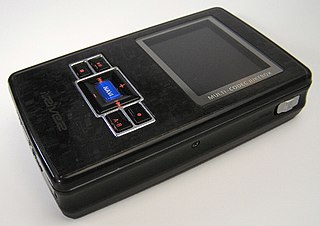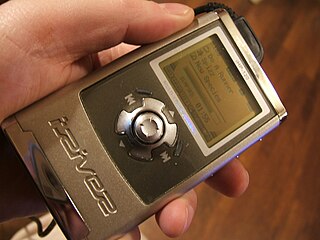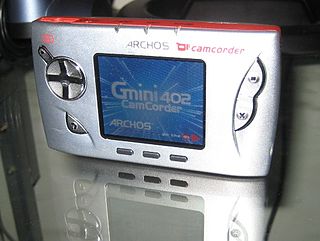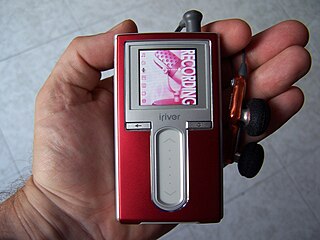Related Research Articles
iRiver is a South Korean consumer electronics division owned by Dreamus which markets music and other accessories in its domestic market.

ZEN is a series of discontinued portable media players designed and manufactured by Creative Technology Limited. The players evolved from the NOMAD brand through the NOMAD Jukebox series of music players, with the first separate "ZEN" branded models released in 2004. The last Creative Zen player, X-Fi3, was released at the end of 2011.

Rockbox is a free and open-source software replacement for the OEM firmware in various forms of digital audio players (DAPs) with an original kernel. It offers an alternative to the player's operating system, in many cases without removing the original firmware, which provides a plug-in architecture for adding various enhancements and functions. Enhancements include personal digital assistant (PDA) functions, applications, utilities, and games. Rockbox can also retrofit video playback functions on players first released in mid-2000. Rockbox includes a voice-driven user-interface suitable for operation by visually impaired users.
Neuros Technology was a Chicago, Illinois–based company that produced a number of audio and video devices under the brand name Neuros. Founded by Joe Born in 2001 as a division of Digital Innovations, it previously operated under the name Neuros Audio. Like Digital Innovations, Neuros distinguished itself by its use of open-innovation and crowdsourcing techniques to bring products to market, as well as by its prominent use of open-source software and open-source hardware. In its development model, end users were involved throughout the product development process from reviewing initial concepts to beta testing initial product releases.

The iRiver H300 series are a series of portable audio players developed by iRiver, made up of the iRiver H320 and H340 models. They were first announced on September 22, 2004 replacing the H100/iHP-100. Each can play music, transfer pictures directly from digital cameras and UMS-compatible devices, such as flash drives, and display digital images on a colour screen. In the United States, the H320 initially retailed for $329 and the H340 was $429.

The iRiver H100 series is a series of discontinued portable digital audio players (DAP) made by iriver and originally released in October 2003. The models in the H100 series differ mainly in hard drive storage capacity. The players were succeeded by the iriver H300 series.

iAUDIO is the brand name for a range of portable media players produced by Korean consumer electronics and software corporation Cowon Systems, Inc.
Flash Video is a container file format used to deliver digital video content over the Internet using Adobe Flash Player version 6 and newer. Flash Video content may also be embedded within SWF files. There are two different Flash Video file formats: FLV and F4V. The audio and video data within FLV files are encoded in the same way as SWF files. The F4V file format is based on the ISO base media file format, starting with Flash Player 9 update 3. Both formats are supported in Adobe Flash Player and developed by Adobe Systems. FLV was originally developed by Macromedia. In the early 2000s, Flash Video was the de facto standard for web-based streaming video. Users include Hulu, VEVO, Yahoo! Video, metacafe, Reuters.com, and many other news providers.

The loosely defined category of S1 MP3 players is comprised by a large amount of then-inexpensive handheld digital audio players. The players were mainly widespread around 2005–2006 but the series continued for years afterwards, blurring into that of so-called "MP4 players" employing S1 and competing architectures.

Yepp was Samsung Electronics' digital audio player brand until Samsung decided to retire most of their family brands in February 2011. From then on, their MP3 players were simply branded "Samsung" worldwide until they discontinued all of them in late 2013. The brand included a wide range of hard-drive based as well as flash-memory based players. The name is claimed to be an acronym for "young, energetic, passionate person".

The iRiver Clix is a portable media player that was developed and sold by iriver through two generations. The Clix was originally known as the U10, released in 2005. The next year it was revised and essentially rebranded to Clix. A second generation player, often called the Clix 2, was released in 2007, and later a minor revision called Clix+. The players are navigated by four buttons embedded on its sides, referred to as D-Click.

My Life Online (mylo) was a device created and marketed by Sony for portable instant messaging and other Internet-based communications, browsing Internet web sites and playback and sharing of media files. The pocket-sized, tablet-shaped handheld device, which debuted in 2006, had a screen which slid up to reveal a QWERTY keyboard. The brand name 'mylo' stands for My Life Online. Using Wi-Fi instead of cellular networks, the mylo was targeted to the 18–24 age group.

SanDisk has produced a number of flash memory-based digital audio and portable media players since 2005. The current range of products bear the SanDisk Clip name, a line of ultraportable digital audio players. SanDisk players were formerly marketed under the Sansa name until 2014.

The Gmini is a series of portable audio and video players released by Archos in 2004 and 2005.

The Archos AV series is a line of portable media players from the company called Archos that was released through 2003 to 2005. This series introduced the digital video recorder for the AV500, an optional feature that would be compatible in subsequent players. Although the AV series did not have standalone digital audio players, Archos did release them under the concurrently released Gmini series.

The Sansa Fuze is a portable media player developed by SanDisk and released on March 8, 2008. The Fuze is available in three different Flash memory capacities: 2 GB, 4 GB, and 8 GB and comes in six different colors: black, blue, pink, red, silver, and white. Storage is expandable via a microSDHC slot with capacity up to 32 GB, and unofficially to 64 GB or more via FAT32 formatted SDXC cards. All models have a 1.9 inch TFT LCD display with a resolution of 220 by 176 pixels and a built-in monaural microphone and FM tuner; recordings of the latter two are saved as PCM WAV files.

The Dingoo is a handheld gaming console that supports music and video playback and open game development. The system features an on-board radio and recording program. It is available to consumers in three colors: white, black, and pink. It was released in February 2009 and has since sold over 1 million units.
The French consumer electronics company Archos manufactured a number of products which have since been discontinued.

The H10 is a series of portable audio players developed by iRiver, coming in multiple capacities and sizes. The player first went on sale in South Korea in December 2004 and rolled out internationally soon afterwards. The H10 series are hard disk based players coming in a 20 gigabyte form, along with smaller variants of 5 or 6 gigabytes. All versions come with a colour screen as well as voice recording and FM radio. Unlike most other iRiver products, the H10 series does not play Ogg Vorbis. However, the device works well with the Rockbox alternative firmware which does play Ogg Vorbis.
The iRiver X20 is a small, flash memory based portable media player (PMP) from iRiver. It was announced at the 2007 Consumer Electronics Show. Initially only 2 and 4 GB versions were announced but soon an 8 GB was also released. It is almost identical to the Insignia NS-DV, a brand from Best Buy.